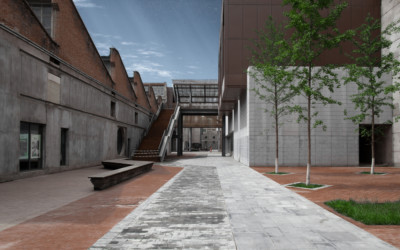Zwei Fotografen, zwei Perspektiven auf die Stadt Xi’an 1999 und 2017.Von Jan Siefke und JIANG Feipeng.


ZHANG Rubing and WANG Keyao are Architects and have worked for China Architecture and Design Group (CADG). In 2012, they founded their own company Zhijian Workshop which not only focusses on renovation research of old and industrial buildings but also undertakes design and art projects in the same field.

You are doing research on industrial transformation in Germany for one year. Could you tell us a bit more about yourself and your research?
Our research title is „Traces of the City“. The project is supported and the sponsored by the German Chancellor Fellowship and Alexander von Humboldt Foundation. With the development of society, many kinds of architectures from different eras have been left in cities. They could be considered as‘traces’of the past. Our research is made up of several aspects of study and discussion. First, the investigation of valuable preserved buildings and renovation projects in Germany. Second, the analysis of accomplished reconstructed architectures and their influence on the city. In addition, we focus on new thinking, new techniques and material which have an impact on the modification work.
Which places in Germany inspire you?
STATIONBerlin (Postbahnhof Luckenwalder Straße) which is situated at the heart of the German capital city is one of the places that inspired us here. When we found this significant trace and urban artefact while taking the U2 and passing by, we were deeply impressed by its superb accessibility, i ts dimension, as well as its architecture as a historic landmark. Now it has been renovated to a hub for innovative ideas, ingenious products and unique events. Today, countless historical and industrial details serve as reminders of STATION-Berlin’ eventful past. 23,000 sqm space have been put to good use as a home for many established and popular events, such as Berlin Fashion Week.
What do you want to achieve during this year’s research?
During this year’s research, we have the opportunity to study renovation works and projects in Germany. The objects of the study are chosen on the basis of their scale (small scale, large scale, urban scale) and according to their different design approaches and principles. Through our research, we would like to start a more interesting exchange of ideas and philosophy, even different points of view between Chinese and German architects and professionals about this topic.
How did you come up with the research focus?
From 2011 to 2014 we have co-designed the renovation of Dahua Cotton Mill in Xi’an. All these experiences during the whole work process gave us a powerful inspiration and made us believe that renovation of old industrial buildings is extremely valuable, especially in the context of China’s high speed development. Since then, we started focusing on not only the renovation investigation, research and design of old industrial buildings, but also on art projects, including art installation, photography, video, etc. The philosophy of all our work is to give people the opportunity to experience the memory and the historic traces in our environment.
What do you see as major challenges for the city of Xi’an and what are the core goals in the city development of Xi’an recently?
We think the major challenge for Xi’an as a city with a long history is how to preserve more historical traces and loci that belong to different ages and how to renovate and reuse them more creatively. The core goal in the city development of Xi’an as presented by the local government is to become an international city which has a role as an advanced manufacturing base, a high-tech agriculture base and a historical culture hub. It also includes supporting micro innovative enterprises and paying attention to the construction of entrepreneurial innovation space and incubators.
Which places to experience daily life, cultural hubs, innovative spaces and design in the city of Xi’an would you recommend to visit?
The Muslim residential area beside the Bell and Drum Tower is one special space in Xi’an. Although it is a popular destination for tourists, people can still experience rich daily life, organic urban texture and local historical culture there. Of course, Xi’an Dahua Cotton Mill – now called Dahua 1935 – is another interesting place to visit. After the renovation, the former factory halls contain new functions, such as a textile museum, an art gallery, a theatre, restaurants, bars and a boutique hotel.
What do you think Chinese cities can learn from German cities?
Any innovation you spotted here in Europe that you think could be interesting to contextualize for China? Various kinds of architecture have been left from different periods of development. Influenced by the war, separation and unification and the industrial transformation, many German cities have carried out renovation projects of historic buildings in the past dozens of years. Additionally, there are many experiences, cases and research papers on how to reuse old buildings and industrial heritage. All these aspects are valuable for Chinese cities to learn from German cities.
ZHANG Rubing & WANG Keyao
Architects, have worked in China Architecture and Design Group (CADG), one of the biggest architecture design group in China for a long time. They took part in several public architecture designs in China. From 2011 to 2014, they were the leading designers in the team for the renovation project of Dahua Cotton Mill. In 2012, they founded their own company Zhijian Workshop which not only focusses on renovation research of old and industrial buildings but also undertakes design and art projects in the same field. They received support and sponsorship to conduct research in Germany from the German Chancellor Fellowship and Alexander von Humboldt Foundation.
Contact & link
yiisaice@163.com
www.zhijianworkshop.com